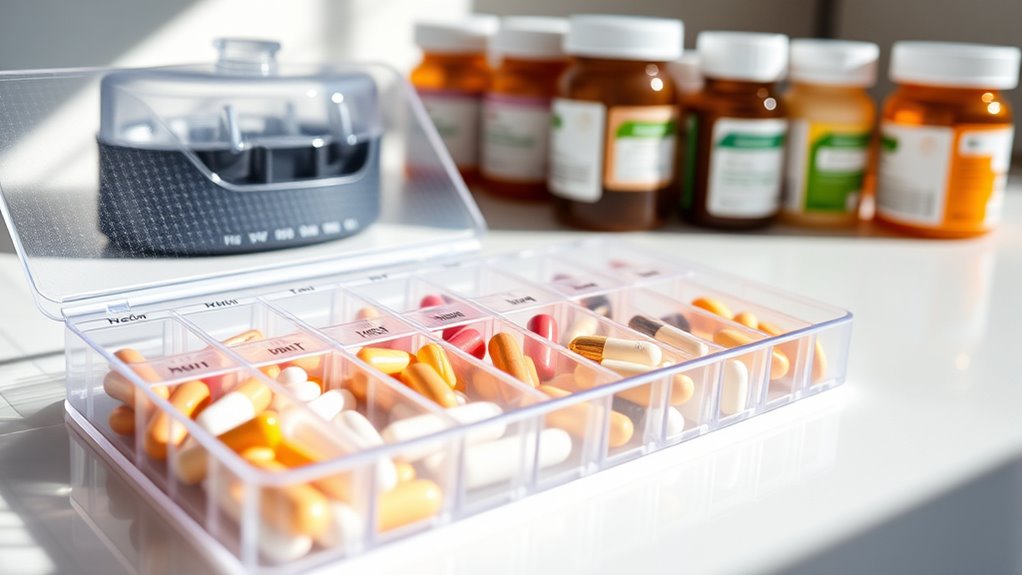To use pill organizers and dispensers effectively, choose a system that matches your medication schedule and label compartments clearly. Incorporate your routine by filling your organizer at the same times daily and checking each dose against prescriptions. Store your organizer in a cool, dry place and review your medications regularly with your healthcare provider. Proper use reduces errors, boosts adherence, and keeps your health on track—keep going to learn more about making it work for you.
Key Takeaways
- Select organizers suited to your medication schedule and clearly label compartments for easy identification.
- Incorporate daily routines, such as morning or evening, to develop consistent medication habits.
- Double-check each compartment against prescription instructions before filling to ensure accuracy.
- Store pill organizers in a cool, dry place away from sunlight to preserve medication potency.
- Regularly review your medication routine with healthcare providers and update your organizer accordingly.

Managing your medications can be easier and more reliable when you use pill organizers and dispensers effectively. These tools are designed to help you stay on top of your prescribed regimen, but their true value depends on how well you utilize them. When it comes to medication safety, the right organization can prevent accidental overdoses or missed doses, ensuring you take the correct medication at the right time. Proper dosage management is essential for your health, and pill organizers are a practical way to keep track of your daily intake, especially if you’re managing multiple medications. By setting up your organizer correctly, you reduce the risk of confusion and mistakes, which can happen when you rely solely on memory or scattered pills.
Start by choosing an organizer that fits your specific needs. If you take several pills throughout the day, a daily or weekly pill box with clearly labeled compartments can help you see at a glance whether you’ve taken your medication. When filling the organizer, double-check each compartment against your prescription instructions to guarantee accuracy. This step is indispensable because misfilled compartments can lead to incorrect dosages, compromising medication safety. Always wash your hands before handling your pills and store your organizer in a cool, dry place away from direct sunlight to maintain medication potency. Incorporating medication management strategies, such as using visual cues or setting reminders, can further enhance adherence.
Consistency is key. Incorporate the use of your pill organizer into your daily routine, such as during morning or evening activities. This habit minimizes the chance of skipping doses or double dosing. If you’re using multiple doses per day, consider a dispenser with built-in alarms or reminders. These features can act as prompts, especially if your schedule is busy or if you’re managing complex medication regimens. Remember, medication safety isn’t just about avoiding overdose—it’s also about ensuring you follow your prescribed timing to maximize effectiveness.
Regularly review your medication routine with your healthcare provider, especially if you notice any changes or side effects. Your provider can advise whether your current organization method is suitable or if adjustments are needed. Keep a list of your medications handy, and verify that your pill organizer matches your current prescriptions. This proactive approach helps prevent errors and keeps your dosage management on track.
In short, using pill organizers and dispensers effectively is a simple yet powerful step toward safer medication practices. When you pay attention to organization, double-check your supplies, and stay consistent, you considerably reduce the risk of medication errors. These small but meaningful actions empower you to take control of your health, ensuring you get the right medication at the right time, every time.
Frequently Asked Questions
How Do I Clean and Disinfect Pill Organizers Safely?
To clean and disinfect your pill organizer safely, start with cleaning methods like washing with warm, soapy water and rinsing thoroughly. For disinfectant options, use a solution with isopropyl alcohol or a diluted household disinfectant that’s safe for plastic. Avoid harsh chemicals that could damage the material. Let it air dry completely before refilling to make certain all residues are gone and your medications stay safe.
Can Pill Dispensers Be Used for Liquids or Only Pills?
Think of your pill dispenser as a versatile toolbox, but only for solid tools. It’s designed specifically for pills and dry medications, so using it for liquids is like trying to fit water into a dry compartment—unsuitable and messy. While some dispensers claim liquid storage, most aren’t built for it, risking leaks or contamination. Stick to your dispenser’s intended use to keep your medications safe and effective.
Are There Specific Organizers for Different Medication Types?
Yes, there are specific organizers for different medication types. You should consider medication sorting to keep pills separate from liquids and topical treatments. Organizer customization allows you to tailor compartments for pills, liquids, or other forms, making your routine more efficient. Using specialized containers helps prevent mix-ups, ensures proper storage, and makes daily medication management easier. Always choose an organizer suited to your medication types for safety and convenience.
How Do I Prevent Pill Spills When Filling the Organizer?
To prevent pill spills when filling your organizer, focus on proper filling techniques and pill spill prevention. Use a small scoop or a folded piece of paper to transfer pills carefully, avoiding overfilling each compartment. Work over a clean, flat surface and fill slowly to prevent spills. Holding the organizer steady with one hand and filling with the other helps maintain control, reducing the risk of accidental spills.
What Should I Do if a Pill Gets Stuck in the Dispenser?
A pill jam can be frustrating, but don’t panic. Gently tap or shake the dispenser to loosen the blockage, then carefully use a small tool like a toothpick to dislodge the stuck pill. Avoid forcing it, which could damage the dispenser. Regular cleaning helps prevent future dispenser blockage. Staying calm and patient guarantees you safely resolve the issue without risking damage or injury.
Conclusion
Think of your pill organizer as a trusted map guiding you through daily health. Just like a well-planned route prevents getting lost, using your dispenser consistently guarantees you never miss a dose. I once met someone who forgot her medication until her organizer reminded her—like a lighthouse guiding her safely home. When you use your pill organizer effectively, you’re steering your health in the right direction, making daily routines smoother and more manageable.









